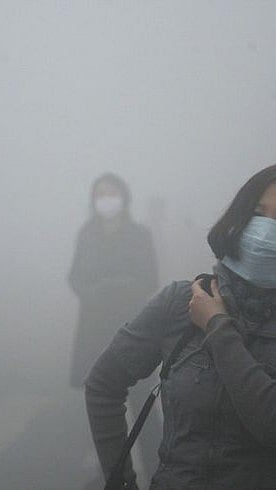A layer of smoky haze lingered over Delhi-NCR on Thursday with air quality in the region hitting 'very poor' levels, even as stricter anti-air pollution measures, including a ban on electricity generators, came into force under the Graded Response Action Plan (GRAP).
Photos from Delhi:

A view of India Gate hiding in smog as the air quality deteriorates in the national capital with rising of pollutants in the atmosphere, in New Delhi on Wednesday. | ANI

Two children play with a ball in a smoggy morning as the air quality deteriorates. | ANI

New Delhi: A view of birds flying while India Gate unseen due to smog as the air quality deteriorates in the national capital with rising of pollutants in the atmosphere, in New Delhi on Wednesday. | (ANI PHOTO/Prabhat Mehrotra)

A view of India Gate hiding in smog as the air quality deteriorates in the national capital with rising of pollutants in the atmosphere, in New Delhi on Wednesday. | (ANI PHOTO/Prabhat Mehrotra)

A view of Rajpath area unseen due to smog as the air quality deteriorates in the national capital with rising of pollutants in the atmosphere, in New Delhi on Wednesday. | ANI

A man jogs along Rajpath street during a smoggy morning in New Delhi on October 15, 2020. | (Photo by Jewel SAMAD / AFP)
Meanwhile, NASA's satellite imagery showed a large cluster of farm fires near Amritsar, Firozpur and Faridkot in Punjab and Patiala, Ambala and Rajpura in Haryana.
However, the Ministry of Earth Sciences' Air Quality Early Warning System for Delhi said its impact on the capital's air quality was marginal.
The city recorded an air quality index (AQI) of 315 at 11:10 am. The last time the air quality hit such a poor level was in February.
The 24-hour average AQI was 276 on Wednesday, which falls in the 'poor' category. It was 300 on Tuesday, 261 on Monday, 216 on Sunday and 221 on Saturday.
ITO (AQI 372), Vivek Vihar (AQI 370), and Shadipur (AQI 359) recorded the highest pollution levels on Thursday morning.
The air quality in the neighbouring cities of Faridabad (317), Ghaziabad (326), Greater Noida (344) and Noida (314) was also in the red zone.
An AQI between 0 and 50 is considered 'good', 51 and 100 'satisfactory', 101 and 200 'moderate', 201 and 300 'poor', 301 and 400 'very poor', and 401 and 500 'severe'.
A senior scientist at the India Meteorological Department said the dip in the air quality can be attributed to low wind speed which allowed accumulation of pollutants.
PM10 levels in Delhi-NCR rose to 300 microgram per cubic meter (µg/m3) at 9:30 am -- the highest this season so far. PM10 levels below 100 µg/m3 are considered safe in India.
PM10 is particulate matter with a diameter of 10 micrometers and is inhalable into the lungs. These particles include dust, pollen and mold spores.
The levels of PM2.5 - finer particles which can even enter the bloodstream - were 151 µg/m3. PM2.5 levels up to 60 µg/m3 are considered safe.
GRAP -- a set of anti-pollution measures followed in Delhi and its vicinity towns according to the severity of the situation -- comes into force on Thursday.
It was notified by the Ministry of Environment and Forests in 2017 for implementation through the Supreme Court-mandated Environment Pollution (Prevention and Control) Authority. The measures under GRAP include increasing bus and metro services, hiking parking fees and stopping use of diesel generator sets when the air quality turns poor. When the situation turns "severe", GRAP recommends closure of brick kilns, stone crushers and hot mix plants, sprinkling of water, frequent mechanised cleaning of roads and maximising power generation from natural gas.
The measures to be followed in the "emergency" situation include stopping entry of trucks in Delhi, ban on construction activities and introduction of the odd-even car rationing scheme.
EPCA, however, had earlier told Delhi, Haryana, Rajasthan and Uttar Pradesh that they "should try and avert the need to take other emergency measures for pollution control as the economy is already under stress post-lockdown. Therefore, our combined effort is to ensure that there is no further disruption".
With Delhi-NCR bracing for months of poor air quality, experts have warned that high levels of air pollution can aggravate the COVID-19 pandemic.
Severe air pollution in Delhi is a year-round problem, which can be attributed to unfavourable meteorological conditions, farm fires in neighbouring regions and local sources of pollution.
According to an analysis by the Council on Energy, Environment and Water, a Delhi-based think tank, transportation contribute the most -- 18 to 39 percent -- to Delhi's air pollution.
Road dust is the second-largest source of air pollution in the city (18 to 38 percent), followed by industries (2 to 29 percent), thermal power plants (3 to 11 percent) and construction (8 percent).











